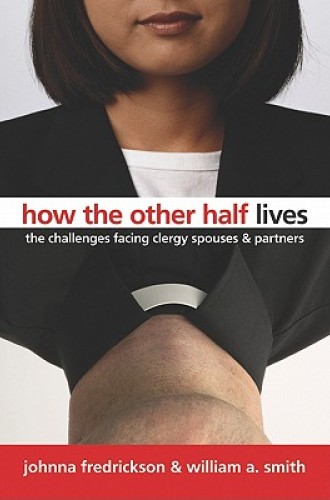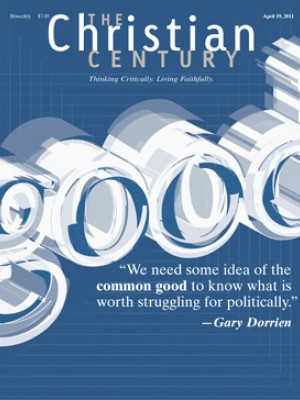How the Other Half Lives, by Johnna Fredrickson and William A. Smith
In 1995, as I was beginning a sabbatical to study older women married to clergy, a longtime seminary professor gave me a book from his library and told me about a class called "Mistress of the Manse" that had been offered for many years to seminarians' wives. The 1965 book, The Minister's Wife as a Counselor, by Wallace Denton, was based on interviews with 45 women representing five denominations. Denton declared that most pastors' wives offered informal counseling to parishioners and that they constituted an important though often invisible component of the mental health system.
Coincidentally also in 1965, William Douglas's book Ministers' Wives appeared. It reported on a study begun in 1959 that amassed surveys, psychological tests and interviews from 4,777 women representing 37 denominations. Douglas, a Presbyterian minister teaching at Boston University School of Theology, believed that marital relations affected clergy effectiveness and that women married to clergy suffered from constraints imposed by multiple social stereotypes. He thought that the information he gathered (thanks to a large grant from the Lilly Endowment) was crucial to the health of American Protestantism, and he expected that seminaries and judicatory bodies would use his findings to develop programs offering psychosocial support to clergy families.
Read our latest issue or browse back issues.
When my husband entered seminary in 1970, just as the second wave of feminism was gathering force, there were no courses on how to manage the manse or counsel parishioners. I recall no discussions of the kinds of fulfillments and frustrations that Douglas identified in the women he studied. In fact, because I was busy preparing for my own career, I paid little attention to the nature of the social role bequeathed to me by virtue of my husband's call to enter the ministry. Our denomination offered retreats for clergy wives, but I never attended them. I assumed that they were for women whose identity was solely shaped around being someone's wife, an identity I was unprepared to assume.
Nevertheless, my husband and I could have benefited from some of the advice offered in How the Other Half Lives: The Challenges Facing Clergy Spouses and Partners. Johnna Fredrickson, a clergy spouse now serving as a Christian educator at St. John the Evangelist Episcopal Church in Duxbury, Massachusetts, and William A. Smith, a private practitioner of marriage and family counseling, have written a book that could appropriately be used in a 21st-century version of a "Mistress of the Manse" class.
Until my sabbatical study, I had no idea that prior to the Civil War, when itinerancy was common in American evangelicalism, clergy wives preached, held revivals, formed women's religious organizations and generally embraced the idea that church work was the only way they could rebel against social expectations that women should be "frivolous, delicate, submissive, and inactive," as Leonard Sweet put it in his 1983 book, The Minister's Wife: Her Role in Nineteenth-century American Evangelicalism. Sweet claimed that in the 19th century, marrying a minister was "a passport to influence, deference, and power."
Two of the most dramatic recent changes in American Protestantism have been the movement of women into clergy roles and the acceptance in some denominations of gay and lesbian clergy. Many of these individuals have come to ordination after having already experienced one or more careers outside of ministry. Therefore, we need new models for clergy couples and different ways of understanding their relationships and roles in congregations. However, despite Fredrickson and Smith's inclusive language, they have little specific to say about challenges faced by men married to clergywomen or by gay and lesbian partners of pastors. This may be due to a lag in research on these roles, and also because their focus is more on the relationship and less on the individuals in the relationship.
Although few people today view either the clergy role or that of the spouse or partner as "a passport to influence, deference, and power," the authors contend that some still fall into the trap of equating their role with their identity. They repeatedly remind readers that persons in these relationships are equals as followers of Jesus and that "true identity resides in God's delight rather than in a particular role." They warn against developing a religious facade and becoming "professionally religious rather than professing the faith."
Unlike the two books on ministers' wives published in 1965, which were grounded more in social science than in theology, this new book articulates fundamental assumptions about Christian life from the first chapter, which outlines "baptismal ministry," to the last, which describes the abundant life lived in God's grace and presence. Although I found the repeated references to baptismal ministry off-putting in the first few chapters, I came to respect the authors' efforts to set their work within the specific framework of Christian people trying to live faithfully in complex roles.
A number of the issues addressed in this book apply to persons who have not heard the call to ordination. For example, the authors devote a chapter to the many challenges encountered by dual-career couples. Their chapter on making a house a home contains important insights about the dangerous lures of consumerism. In the chapter on parenthood they argue that parents should not surrender to the idolatrous cultural view that the child should be "the sole focus and purpose of a parent's life," and a chapter on marital conflict summarizes the research of psychologist John Gottman and his colleagues and applies it to couples regardless of their professions.
On the other hand, some topics do relate specifically to persons in ministry. For example, Fredrickson and Smith offer practical advice to couples living in housing owned by the congregation. They address the challenges of practicing Sabbath when one member of the couple is leading the service and the other is sitting alone in the pew (although I think they are wrong about the "alone" part since there are many people in congregations who worship without a spouse or partner). They thoughtfully raise questions about children's responses to relocation to new congregations, including the issue of who should be the child's pastor and how parents should respond when children decide they do not wish to be confirmed or to participate in congregational life. However, because the "PK" designation for clergy children continues to be pejorative, I wish they had not used that term throughout the chapter on "the kids."
As a social scientist, I wanted to know more about the people who were surveyed in preparation for the writing of this book. The authors provide an example of the survey in an appendix and invite readers to participate, but I would have appreciated another appendix giving information about the persons who have already responded—their age and gender, the length of their ministries and of their marriages or partnerships, their denominations, the size and location of their congregations and so on.
Nearly every chapter includes several paragraphs with multiple questions—a rhetorical device that is awkward for the reader but could be quite useful for discussions with others. Some chapters also include exercises, presumably for couples to undertake together.
Although the "Mistress of the Manse" idea has been appropriately relegated to history, there are still specific challenges in 21st-century American Protestantism that are unique to the men and women ordained to ministry, and to the men and women who love them.







